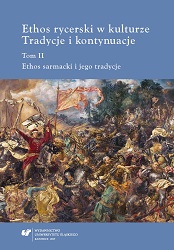Ostatnie rycerstwo Europy. Husaria w utworach Wespazjana Kochowskiego
The Last Knighthood of Europe. Polish Hussars in Wespazjan Kochowski’s Works
Author(s): Dominika Fesser
Subject(s): History, Language and Literature Studies, Literary Texts, Studies of Literature, Philology
Published by: Wydawnictwo Uniwersytetu Śląskiego
Keywords: hussars; Wespazjan Kochowski; Niepróżnujące próżnowanie (Not Idling Idleness)
Summary/Abstract: The aim of this paper is to explore the image of Polish hussars emerging from the writings of Wespazjan Kochowski. The subject of reflection is mostly the ways of fighting of hussar towarzysz and the role of the characteristic hussar weaponry described in Kochowski’s poems. The author of Niepróżnujące próżnowanie (Not Idling Idleness) was sent as part of levy in mass to Berestechko (1651) shortly after graduation. Thenceforth he was in the army until 1660, also in the Crown hussar company of margrave Władysław Myszkowski. Wespazjan Kochowski devoted a large part of his writings to soldier life, famous battles and commanders. This article analyzes the works of a poet‑soldier, in which we find a first‑handDescription of hussars; they include verses from the collection Niepróżnujące próżnowanie (Not Idling Idleness) and excerpts from Commentarius belli adversus Turcas ad Viennam (Memoirs from the Wars against Turks) and Dzieła Boskiego albo Pieśni Wiednia wybawionego i inszych transakcyjej wojny tureckiej w roku 1683 szczęśliwie rozpoczętej (The Work of God or Songs of Liberated Vienna).
Book: Ethos rycerski w kulturze. Tradycje i kontynuacje. T. II: Ethos sarmacki i jego tradycje
- Page Range: 114-130
- Page Count: 17
- Publication Year: 2017
- Language: Polish
- Content File-PDF

